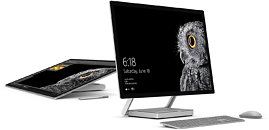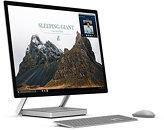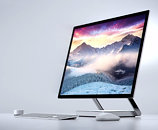Raevenlord
News Editor
- Joined
- Aug 12, 2016
- Messages
- 3,755 (1.23/day)
- Location
- Portugal
| System Name | The Ryzening |
|---|---|
| Processor | AMD Ryzen 9 5900X |
| Motherboard | MSI X570 MAG TOMAHAWK |
| Cooling | Lian Li Galahad 360mm AIO |
| Memory | 32 GB G.Skill Trident Z F4-3733 (4x 8 GB) |
| Video Card(s) | Gigabyte RTX 3070 Ti |
| Storage | Boot: Transcend MTE220S 2TB, Kintson A2000 1TB, Seagate Firewolf Pro 14 TB |
| Display(s) | Acer Nitro VG270UP (1440p 144 Hz IPS) |
| Case | Lian Li O11DX Dynamic White |
| Audio Device(s) | iFi Audio Zen DAC |
| Power Supply | Seasonic Focus+ 750 W |
| Mouse | Cooler Master Masterkeys Lite L |
| Keyboard | Cooler Master Masterkeys Lite L |
| Software | Windows 10 x64 |
At the 2016 annual Microsoft Surface Event, Microsoft's corporate vice president for Surface Computing Panos Panay announced a new addition to the company's Surface lineup: a 28-inch All-in-One, with a 3:2 aspect ratio monitor Microsoft calls a "Pixel Sense Display", packing a 4500x3000 resolution (with around 62% more pixels than 4K resolution, combining to provide about 192 pixels per inch), as well as 10-point touch and Microsoft Pen support.
All of that screen real-estate comes in at just 12.5mm thick - the AIO's innards are actually on the monitor's base, with an hinge that promises to allow the display to be moved seamlessly and in a wide variety of angles, as well as allowing it to take on extra weight in studio mode. All of this is powered by an Intel Skylake processor (configurable as an i5 or i7 model), your choice of an NVIDIA GTX 965 M 2GB or an NVIDIA GTX 980 M 4 GB model, 8 through 32 GB of DDR4 RAM, and a 1 TB or 2TB storage - with all configurable options also including in their base specs what Microsoft calls a "Rapid Hybrid Drive", which at the moment, remains unclear as to its nature of either a SATA or PCIe SSD, or even an SSHD.




The product is positioned more towards content creators than consumers, though it can certainly service both of those demographics. For those looking to take a more professional use out of their Surface Studio, Microsoft is advertising the display as supporting both DCI-P3 and sRGB with a simple toggle on the Windows sidebar to switch between the two. Microsoft is also launching what it calls a Microsoft Dial, which when in contact with the Surface Studio's screen, allows users to move along a timeline by simply rotating the dial, or pressing it so as to get a contextual menu related to the app they're currently using.
Pricing for this piece of tech, which looks more like a statement of style rather than technical achievement (with the hardware parts, with exception of the Pixel Sense Screen, being a generation old), is sure to prove eye-watering to any normal consumer: the base model (with a Skylake i5, GTX 965 M, 8 GB DDR4 and 1 TB storage) comes in at $2999, with the top model (packing a Skylake i7, a GTX 980 M, 32 GB of DDR4 RAM and 2 TB storage) upping the ante towards $4199.



View at TechPowerUp Main Site
All of that screen real-estate comes in at just 12.5mm thick - the AIO's innards are actually on the monitor's base, with an hinge that promises to allow the display to be moved seamlessly and in a wide variety of angles, as well as allowing it to take on extra weight in studio mode. All of this is powered by an Intel Skylake processor (configurable as an i5 or i7 model), your choice of an NVIDIA GTX 965 M 2GB or an NVIDIA GTX 980 M 4 GB model, 8 through 32 GB of DDR4 RAM, and a 1 TB or 2TB storage - with all configurable options also including in their base specs what Microsoft calls a "Rapid Hybrid Drive", which at the moment, remains unclear as to its nature of either a SATA or PCIe SSD, or even an SSHD.




The product is positioned more towards content creators than consumers, though it can certainly service both of those demographics. For those looking to take a more professional use out of their Surface Studio, Microsoft is advertising the display as supporting both DCI-P3 and sRGB with a simple toggle on the Windows sidebar to switch between the two. Microsoft is also launching what it calls a Microsoft Dial, which when in contact with the Surface Studio's screen, allows users to move along a timeline by simply rotating the dial, or pressing it so as to get a contextual menu related to the app they're currently using.
Pricing for this piece of tech, which looks more like a statement of style rather than technical achievement (with the hardware parts, with exception of the Pixel Sense Screen, being a generation old), is sure to prove eye-watering to any normal consumer: the base model (with a Skylake i5, GTX 965 M, 8 GB DDR4 and 1 TB storage) comes in at $2999, with the top model (packing a Skylake i7, a GTX 980 M, 32 GB of DDR4 RAM and 2 TB storage) upping the ante towards $4199.



View at TechPowerUp Main Site
Last edited:




